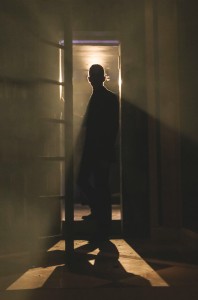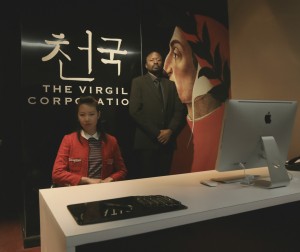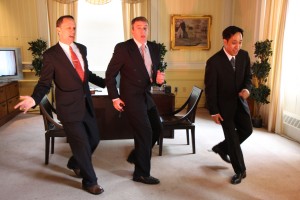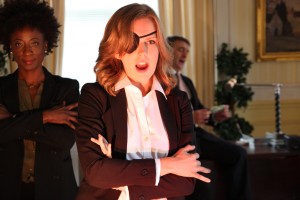Although the Parisian cabaret the Moulin Rouge was most recently popularized by Baz Luhrmann’s fantastical 2001 film musical, it was French painter Henri de Toulouse-Lautrec’s posters that brought fame to the venue during its original heyday in the late 19th century. Colorful and grotesque, his works depicted the excess, revelry, and bohemian lifestyles that defined the neighborhood of Montmartre at that time. In Unmaking Toulouse-Lautrec, Bated Breath Theatre Company delivers a quick and dirty look at the man behind the paintings in NoHo’s sexy, velvet-saturated bar Madame X (a venue that befits the bordello stylings of the production’s historical time period).
The Hidden Ones
During the Holocaust, the atrocities of the Nazi regime forced countless Jewish families and individuals into hiding. Though they were not interned in concentration camps, these stowaways were subjected to another, silent, reign of terror—in which every creak and cough could result in discovery, detainment, and almost certain death. Thus, the scene is set for The Hidden Ones, an immersive theater production that brings audiences into the secret hiding place of two families at the end of World War II
The Trial of Typhoid Mary 1915
Since 2009, Live In Theater has reimagined the murder mystery genre by staging historic events within various nontraditional theatre spaces throughout New York City. The group specializes in interactive, true crime stories, putting some audience members at the center of the action. In The Trial of Typhoid Mary 1915, viewers are faced with the case of Mary Mallon, a domestic cook for affluent New York families during the early 1900s. As a silent carrier of the contagious bacteria that causes typhoid fever, Mallon infected more than 50 New Yorkers, resulting in at least three deaths. However, while Mallon was certainly not the only carrier of the disease, her status as an immigrant woman may have disadvantaged her in the justice system. It is up to the audience to decide whether Typhoid Mary should remain in quarantine for the rest of her natural life or be set free.
The Seagull
The Instigators’ adaptation of Anton Chekhov’s The Seagull, directed by Lillian Meredith, uses immersive elements to enhance and punctuate both large and small moments. Actors break the fourth wall, and the staging brings actors in line with the audience.
A Paradise for Paranoia
You are locked inside the small lobby of a corporate office building with 10 other strangers. An ominous voice on an intercom informs your group that you have one hour to escape. The lights go out. A screen flickers on, flashing random surreal images quicker than your brain can process. A human eye; a girl in a forest; a Romantic painting; an architectural spiral. Everyone panics.
This might sound like a nightmare, but it's actually the beginning of Paradiso Chapter 1, a self-described immersive theatrical escape room experience located in Korea Town. Created by theatrical innovator Michael Counts, Paradiso tries to set itself apart from other New York City escape rooms by incorporating several rooms of immersive theater, live actors, and "existential themes." Despite these claims, however, Paradiso does not escape the genre of escape rooms, which is limited by design.
Originating in the early 2000s, escape rooms have gained popularity in many cities across the world, especially in Asia and the U.S. In New York alone, there are dozens of escape rooms to choose from. The concept is simple, but the design can be very complicated: groups of participants are put inside a room or series of rooms and must solve a gauntlet of puzzles within a set time in order to "escape." Many of these rooms have themes. Paradiso Chapter 1 seems to evoke corporate corruption similar to dystopian film and TV shows like Mr. Robot or V for Vendetta, with scattered references to Dante's Divine Comedy.
The Paradiso experience begins days in advance with a series of cryptic text instructions sent to your personal cell phone. A few hours before, you are instructed to meet at an obscure karaoke bar in K-Town. While this messaging system seemed to work for some participants, for one technical reason or another, several others did not receive correspondence. A set of email instructions advice participants to surrender all of their belongings to storage before the experience, but no such check was mandated (only offered to participants who wanted to shed their bags). This meant that, for better or for worse, our group relied on our cell phones throughout the experience—for illumination, notes, or recording clues or images.
During the experience, actors appear to help or hinder your quest to escape. Sarah Jun, Claire Sanderson, Joe Laureiro, and Brian Alford all manage to develop interesting characters within the confines of the escape room format. It is unclear exactly what is at stake, but it seems as if Virgil Corporation is trying to cover up some secrets hidden within their commercial empire. It is left ambiguous whether any of the characters are sympathetic to Virgil Corporation, or whether they are sincerely trying to help you escape. With such a talented cast at hand, Paradiso might consider developing a clearer storyline and incorporating each actor further into the fabric of the experience, perhaps to develop a storyline and to offer insight into the show's supposed existential themes. Instead, the actors felt more like fancy props, limited to (with the exception of Jun) garbled utterances about clues.
Escape rooms, by nature, are different every time. One may or may not escape, depending on the speed at which their group finds and interprets clues correctly. Paradiso claims to incorporate immersive theater techniques, but do not expect the same level of detail as the exquisitely designed sets of companies like Punchdrunk or Third Rail. These immersive companies take precise care to make sure that every object within the interactive set tells a story. The objects in Paradiso seem more haphazard. Additionally, many immersive theater productions, such as Tony & Tina's Wedding, allow participants to talk to the characters and piece together a narrative through their interactions. However, do not expect to interact meaningfully with the characters as one might in local immersive productions such as Speakeasy Dollhouse or The Grand Paradise Hotel.
Escape rooms are not for everyone, but if you enjoy high-pressure gaming environments, definitely attend Paradiso: Chapter 1. Be aware that the pace is fast, the energy is high, and the rooms can become very hot. If immersive and interactive theater is more your thing, consider skipping this one. Our group was unsuccessful in escaping, and Alford's character booted us to the curb as quickly as Jun's had swept us in. Despite failing, it was a unique experience, and will definitely get your adrenaline going.
The open-ended run of Paradiso: Chapter 1 plays Wednesday–Friday from 6–9:30 p.m., Saturday from 2–9.30 p.m., and Sunday from 2–8:30 p.m., with audiences entering every half hour. Paradiso: Chapter 1 takes place at a secret location in Korea Town that is not unveiled until audiences arrive at a designated meeting point shared when their tickets are booked. Tickets start at $45 and are available via www.paradisoescape.com. Advance booking is required.
Gather, Ye Illuminati Hopefuls
In 1972, wealthy Parisian socialite Marie-Hélène de Rothschild threw an elaborately occult Illuminati Ball at her family’s chateau. Guests of honor included Salvador Dali and Audrey Hepburn, and the coveted invitations requested “black tie, long dresses, & Surrealist heads.” Today, nearly 50 years later, immersive maven Cynthia von Buhler reimagines the Illuminati Ball at her estate, and her guest list could include you. Known for her previous immersive productions Speakeasy Dollhouse and Midnight Frolic, von Buhler is at it again with her most exclusive experience yet.
Like the original Rothschild event, von Buhler takes care to construct an atmosphere of selectivity and secrecy beginning at the participant’s initial point of entry. Potential guests must apply for attendance and, once chosen, are delivered precise instructions on what to wear and where to meet. Von Buhler then shuttles participants to her estate via a limousine fitted with blackout curtains. For even the most seasoned immersive theatergoers, the secretive applications, invitations, and strict instructions are enough to drum up some excitement and anticipation about the evening to come.
While the individual talents of the interspersed performances provide ample diversions, certain aspects of The Illuminati Ball disrupt its immersive flow. A bit of shuffling amongst organizers while boarding and riding the limousine partially dispels the illusion that participants are actually being considered for candidacy in the Illuminati. While it is no small feat to conceal the complicated logistics involved in such an elaborate immersive experience, the success of the production relies on this very concealment. Furthermore, Illuminati Ball seems only partially committed to its narrative. Some performers, such as the honey-voiced Eden Atencio as Kamadhenu and von Buhler herself as the heiress of the estate, seem more committed to interacting candidly with audience members. Other characters seem more concerned with advancing the plot, which crescendos confusingly in the middle of dessert. Transitions between dinner, group scenes, and individual interactions feel a bit like herding cats.
Casting the production’s somewhat disjointed storyline aside, Illuminati Ball provides something else far more special in its discarding of the fourth wall. The ability to eat with and interact with the actors and the fellow attendees is the production’s greatest joy.
The conviviality is amplified by the evening’s spread of small plates and cocktails, the quality of which far surpasses any usual dinner theater fare. The dinner, lovingly prepared and artfully plated by chef Erin Orr, consists of delightful colors and textures. The real sorcerer behind this production is mixologist Bootleg Greg, whose (virtually unlimited) flavorful concoctions fuel the evening’s revelry. For better or for worse, the drama of Illuminati’s muddled storyline is eclipsed by the evening’s more sensual pleasures of food, drink, socialization, music, and dance. In any case, the most pleasant surprise of The Illuminati Ball is its unique ability to facilitate connections among audience members, actors, and performers as they carouse in the moonlight.
The Illuminati Ball: An Immersive Excursion by Cynthia von Buhler runs bi-monthly on Saturday evenings through Aug. 20 (specific dates here) at 6 p.m. at a secret location one hour outside of Manhattan. Apply for attendance here.
Brittle Steel Magnolias
Immersive performance experiences usually toe the blurry line between smashing through the fourth wall and discomfiting the audience with its intimacy. But when onlookers can cling to the familiarity of a tried and true theme, a delightful complacency settles in, and expectations tend to plateau. In director/choreographer/creator Mary John Frank's production of Debutaunt, five Southern belles conduct their coming-of-age rituals through an “interactive dance-based experience” complete with forehead-to-floor bows and book-balancing posture exercises.
Girls! Girls! Girls!
Occluded by a flashy, tourist-ridden diner on 42nd Street, the decaying splendor of the old Liberty Theater provides the perfect bootleg venue for Midnight Frolic, the third interactive show in the Speakeasy Dollhouse series by author, artist and playwright Cynthia von Buhler. The sparkling acrobatic, musical, and dance numbers stand out in this production as palimpsests of the indulgent variety shows of Florenz Ziegfeld's heyday in New York City; however, though from the beginning Midnight Frolic promises interactivity and immersion, it is far too busy being a vaudeville show to enfold audience participants into its world.
Invest In Your Theater Experience
If you thought Governors Island was only for bicycling, picnics and electronic music concerts — think again! Because theater visionaries David Evans Morris and Kristin Marting have transformed the island's historic Pershing Hall into a "living market" for their latest immersive theater creation entitled Trade Practices, which kicks off the 2014-15 season at HERE Arts Center. Like our nation's economy, Trade Practices is intricately structured and impossible to wrap your head around. The rooms of Pershing Hall have been transformed into departments of a fictional currency-printing corporation, Tender, Inc. Each audience member receives a roll of cash and, accordingly, the power to invest their time and "money" into whichever storyline they choose. Part of the fun and frustration of Trade Practices (and immersive theater in general) is knowing that every audience member's experience must be different, and that one can't possibly see or experience everything.
By dividing the threads of action into separate spaces, Marting and Morris have created for themselves an unprecedented freedom to play with style and form. Within each plot line, the collaborators dive enthusiastically into genres such as satire, participatory theater, dance, melodrama, musical theater, and so much more. More emphasis is placed on unity of theme or thought than stylistic or aesthetic unity (as in Punchdrunk's cinematic behemoth of immersive theatre, Sleep No More). Yet this schizophrenia of style works wonderfully for the piece, ensuring that audience members are never, ever bored and never, ever sure what is going to come next.
A particularly charming stylistic tangent is the musical numbers performed in the "Owners" story line, as well as every incident of full-ensemble choreography that takes place on the trade floor, where the entire audience convenes between each plot episode. These dance numbers smack of the virtuosic yet amateurish choreography of Elevator Repair Service productions, as well as the quirkily empowered dance moments in the work of Young Jean Lee (no surprise since Trade Practices incorporates actors and collaborators from both). Fully committed to the song and dance, the brilliant ensemble cast is present at every moment — be it wacky, heartfelt or politically charged.
The complexity and thought behind the text of Trade Practices (written by Eisa Davis, Robert Lyons, Erin Courtney, Qui Nguyen, KJ Sanchez, and Chris Wells) indicates some serious dramaturgy and research, and the program indicates a bevy of bankers and financial workers that lent their knowledge to the project. There are times, however, that the finance-speak becomes overwhelming for those of us without a banking background. Rather than weighing down the piece, however, these moments only serve to enhance the feeling of intricacy and insurmountability of the economy — a formidable beast of our own creation. For audience members who are finance-savvy, the moments of intense economic debate are likely to be stimulating. Regardless, Trade Practices manages to unmask the relationship between money, power and the human condition. The results are messy, but undoubtedly thought-provoking (and worth the ferry ride to Governors Island).
Trade Practices ran until Sept. 21 at HERE Arts Center (145 Avenue of the Americas). For more information, please visit www.here.org.















